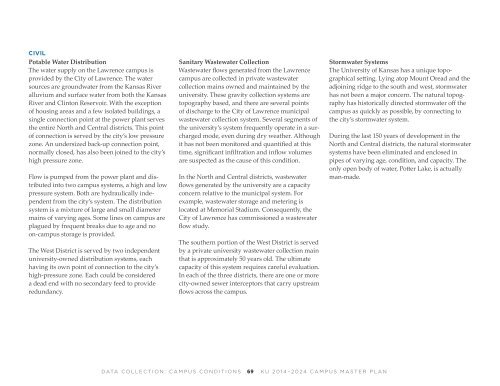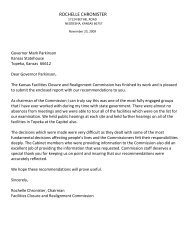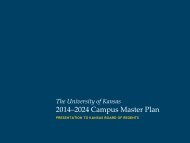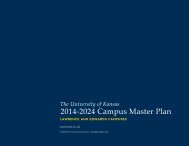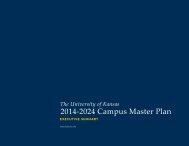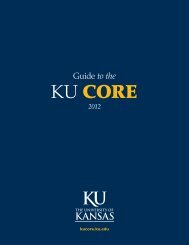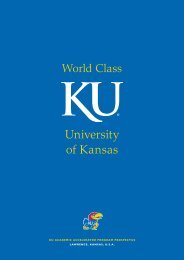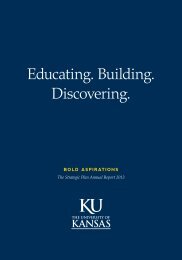KU_Chapter01_DataCollection_2014-06-10
KU_Chapter01_DataCollection_2014-06-10.pdf
KU_Chapter01_DataCollection_2014-06-10.pdf
- No tags were found...
Create successful ePaper yourself
Turn your PDF publications into a flip-book with our unique Google optimized e-Paper software.
CIVIL<br />
Potable Water Distribution<br />
The water supply on the Lawrence campus is<br />
provided by the City of Lawrence. The water<br />
sources are groundwater from the Kansas River<br />
alluvium and surface water from both the Kansas<br />
River and Clinton Reservoir. With the exception<br />
of housing areas and a few isolated buildings, a<br />
single connection point at the power plant serves<br />
the entire North and Central districts. This point<br />
of connection is served by the city’s low pressure<br />
zone. An undersized back-up connection point,<br />
normally closed, has also been joined to the city’s<br />
high pressure zone.<br />
Flow is pumped from the power plant and distributed<br />
into two campus systems, a high and low<br />
pressure system. Both are hydraulically independent<br />
from the city’s system. The distribution<br />
system is a mixture of large and small diameter<br />
mains of varying ages. Some lines on campus are<br />
plagued by frequent breaks due to age and no<br />
on-campus storage is provided.<br />
The West District is served by two independent<br />
university-owned distribution systems, each<br />
having its own point of connection to the city’s<br />
high-pressure zone. Each could be considered<br />
a dead end with no secondary feed to provide<br />
redundancy.<br />
Sanitary Wastewater Collection<br />
Wastewater flows generated from the Lawrence<br />
campus are collected in private wastewater<br />
collection mains owned and maintained by the<br />
university. These gravity collection systems are<br />
topography based, and there are several points<br />
of discharge to the City of Lawrence municipal<br />
wastewater collection system. Several segments of<br />
the university’s system frequently operate in a surcharged<br />
mode, even during dry weather. Although<br />
it has not been monitored and quantified at this<br />
time, significant infiltration and inflow volumes<br />
are suspected as the cause of this condition.<br />
In the North and Central districts, wastewater<br />
flows generated by the university are a capacity<br />
concern relative to the municipal system. For<br />
example, wastewater storage and metering is<br />
located at Memorial Stadium. Consequently, the<br />
City of Lawrence has commissioned a wastewater<br />
flow study.<br />
The southern portion of the West District is served<br />
by a private university wastewater collection main<br />
that is approximately 50 years old. The ultimate<br />
capacity of this system requires careful evaluation.<br />
In each of the three districts, there are one or more<br />
city-owned sewer interceptors that carry upstream<br />
flows across the campus.<br />
Stormwater Systems<br />
The University of Kansas has a unique topographical<br />
setting. Lying atop Mount Oread and the<br />
adjoining ridge to the south and west, stormwater<br />
has not been a major concern. The natural topography<br />
has historically directed stormwater off the<br />
campus as quickly as possible, by connecting to<br />
the city’s stormwater system.<br />
During the last 150 years of development in the<br />
North and Central districts, the natural stormwater<br />
systems have been eliminated and enclosed in<br />
pipes of varying age, condition, and capacity. The<br />
only open body of water, Potter Lake, is actually<br />
man-made.<br />
DATA COLLECTION: CAMPUS CONDITIONS<br />
69<br />
<strong>KU</strong> <strong>2014</strong>–2024 CAMPUS MASTER PLAN


